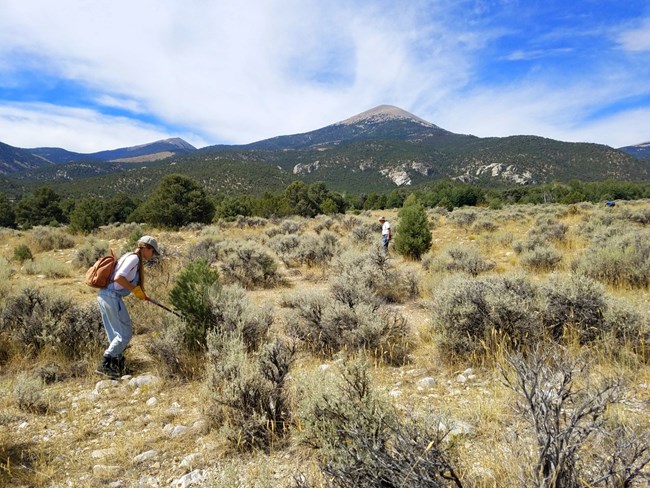Part of a series of articles titled The Midden - Great Basin National Park: Vol. 18, No. 2, Winter 2018.
Article
Utah Master Naturalists Help with Restoration
This article was originally published in The Midden – Great Basin National Park: Vol. 18, No. 2, Winter 2018.

At the end of August, Mark Larese-Casanova brought about ten people to the park as part of the Utah Master Naturalist program from Utah State University. This is a continuing education program open to all ages. During their three-day stay in the park, they hiked to the bristlecones, assisted with bat trapping and data collection at Rose Guano Cave, took a cave tour, and enjoyed the sound of Baker Creek while camping at Grey Cliffs. They also offered to do a service project.
For the service project, I met them at the Gravel Pit along the Scenic Drive and did a talk about sagebrush restoration. I started with a discussion of conifer encroachment. Pinyon pines, a relatively new tree species on the landscape, arriving just 6,000 years ago, have increased over the last 150 years and now occupy 18 million acres in the Great Basin. These trees occupy the thermal belt, above winter inversions but below other conifer species such as ponderosa pine and Englemann spruce. Due to human induced factors such as fire suppression, increased carbon dioxide, and changing climate, pinyon pines are increasing in sagebrush stands. Sagebrush steppe habitat is full of biodiversity, including species that favor it like sage grouse, sage thrasher, sage sparrow, sagebrush lizard, pronghorn, and more. Pinyon-juniper woodlands do not contain as much biodiversity and very few habitat specialists.
Additionally fuel loads in pinyon juniper woodlands are higher than sagebrush steppe, and can create catastrophic wildlifes leading to cheatgrass monocultures. For these reasons, we have done multiple conifer removal projects in the Park to restore the shrinking sagebrush habitat.
For the service project, each person was provided with gloves and loppers and instructions on how to cut the small pinyon and juniper trees. Then we headed to the historic park road, fanned out, and headed out into the meadow above it. Over the next hour and a half, these volunteers lopped and scattered many small trees. Most trees were growing right in or next to sagebrush, as the pinyon trees prefer a nurse plant such as sagebrush for extra protection. The Utah Master Naturalists covered the entire 15-acres of the meadow and provided 1.5-days worth of work. It was definitely a win-win: the master naturalists got to help out the park and we made progress on our goals for the Wildrye Restoration project.
This type of service project is ideal for groups of 6-12 people, aged teenagers or above, who are looking for about a two-hour long service project. If you have folks who are interested in volunteering, have them contact Bryan Hamilton.
Last updated: February 26, 2024
